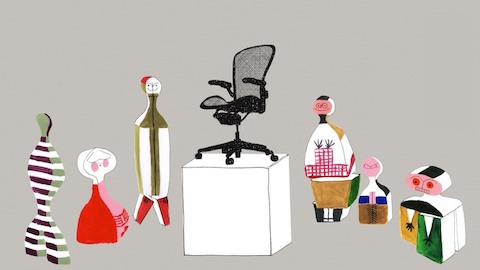Trained as an architect, but proficient in all manner of activities, Alexander Girard was introduced to Herman Miller through Charles Eames and George Nelson, established the Herman Miller Textile Division in 1952, and served as its Director of Design until 1973. From his outpost in Santa Fe, New Mexico, he designed over 300 textiles in multitudes of colorways, multiple collections of wallpaper, decorative prints and wall hangings, an expansive group of furniture, and both decorative and useful objects.
His passion for international folk art led him around the globe as he amassed a collection of roughly 106,000 pieces, and his many corporate and freelance assignments—including the La Fonda Del Sol restaurant and the total design program for Braniff International—engendered lavish praise for his diverse skills and unique vision.
With a resolute and reserved personality, Girard believed quality should speak for itself—and he did much to propagate the notion that life should be lived with a higher regard for the humanity of one’s surroundings. His uncommon way of seeing and admirably undogmatic approach to each new solution resulted in an unparalleled body of work that is not only staggering in sheer volume and creativity, but due to its fundamental qualities of beauty and usefulness, remains completely relevant today.
Working closely with the Girard family, Herman Miller and Maharam are pleased to be the official producers of Alexander Girard designs and to make available a range of furnishings, objects, screen-printed panels, and woven textiles.

The space was produced with Brooklyn-based design firm Standard Issue. An archival exhibit introduces visitors to Girard’s many talents and diverse body of work.

In 1965, Girard was hired by Braniff International to orchestrate what amounted to a complete overhaul of their brand experience. From playing cards and matchbooks, to baggage tags and tickets, to the airport lounges and planes, the designer marshaled his talents into a comprehensive scheme that signaled “the end of the plain plane,”and eventually included some 17,543 design changes; The original silk screen for “Palace”and a vintage example of the printed Environmental Enrichment Panel.

This banner was sewn by Girard for the 1975 Walker Art Center exhibit, “ Nelson Eames Girard Propst, The Design Process at Herman Miller.”

For the La Fonda Del Sol restaurant, Girard created what he referred to as a “significant group,” a design program where greater significance is achieved because “each individual piece is enhanced by its relation to the group.”; In 1960, Girard designed a series of neckties for corporate gifts to be given out by Herman Miller salespeople.

A new Bolster sofa by BassamFellows upholstered in Girard’s Superweave textile from Maharam and an Eames Upholstered Molded Fiberglass Arm Chair on a “cat's cradle”base offer visitors a place to lounge.
On the occasion of the first archival reintroductions of furniture and screen-printed fabric panels by Alexander Girard we’re celebrating his life and work with a temporary installation in New York City’s Meatpacking District: “Alexander Girard: An Uncommon Vision.”
A curated exhibit of archival designs including textiles, objects, folk art, ephemera, and furniture provides an introduction to the iconic
While Girard focused his abilities at Herman Miller on the textile program, he had a long history of designing furniture for other projects and clients. For

Girard's Color Wheel Ottomans and Eames Upholstered Molded Fiberglass Arm Chairs form the basis of a Girard-inspired living room.

A hexagonal composition of 216 inscribed triangles makes up the jewel-like, polished aluminum tops of these exquisite tables; A stellar archival example of a T&O Shop Mirror designed by Girard in the 1960s.

“Geometry”(left) and “Double Heart”(right) are among the new Environmental Enrichment Panels being introduced this fall. “Sign”(middle) is an archival example.

The Color Wheel Ottoman will be available in four color combinations, and two Maharam stripes; The colorful and lovely “Girls” is an archival example of a printed Environmental Enrichment Panel.
In 1972, Girard developed 40 decorative silkscreen designs to add an element of “aesthetic functionalism” to corporate environments. Unlike his printed textiles, the panels consist of single, stand-alone images that range from abstract patterns to figurative pictograms. Herman Miller is pleased to make 12 of these designs available once again.
Maharam has reissued 18 Girard patterns to date as part of its Textiles of the 20th Century series, which is dedicated to faithfully re-editioning the work of modern design icons. Girard’s mastery of the textile medium has made his designs—with their complex constructions, unusual yarns, and array of vibrant colors—among the most challenging to reproduce.
“Alexander Girard: An Uncommon Vision” is now open through May 28 at 446 West 14th Street, New York—daily from 11 am to 6 pm. Please drop by, or see what people are sharing on social media by following the hashtag #GirardNYC.

“Alexander Girard: An Uncommon Vision” is open to the public daily from 11 a.m. to 6 p.m. In New York’s Meatpacking District.



